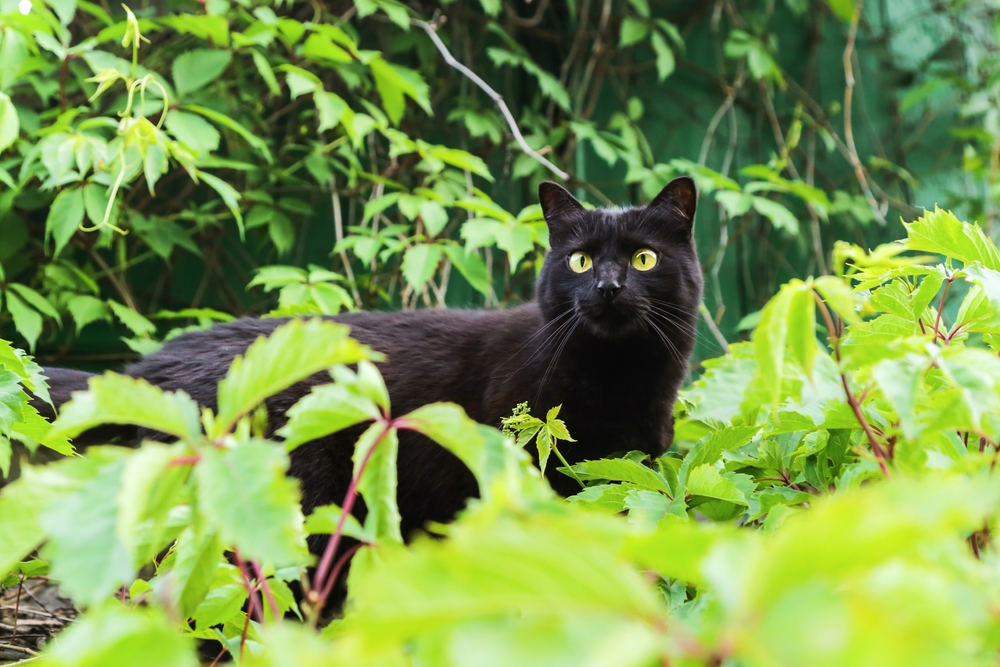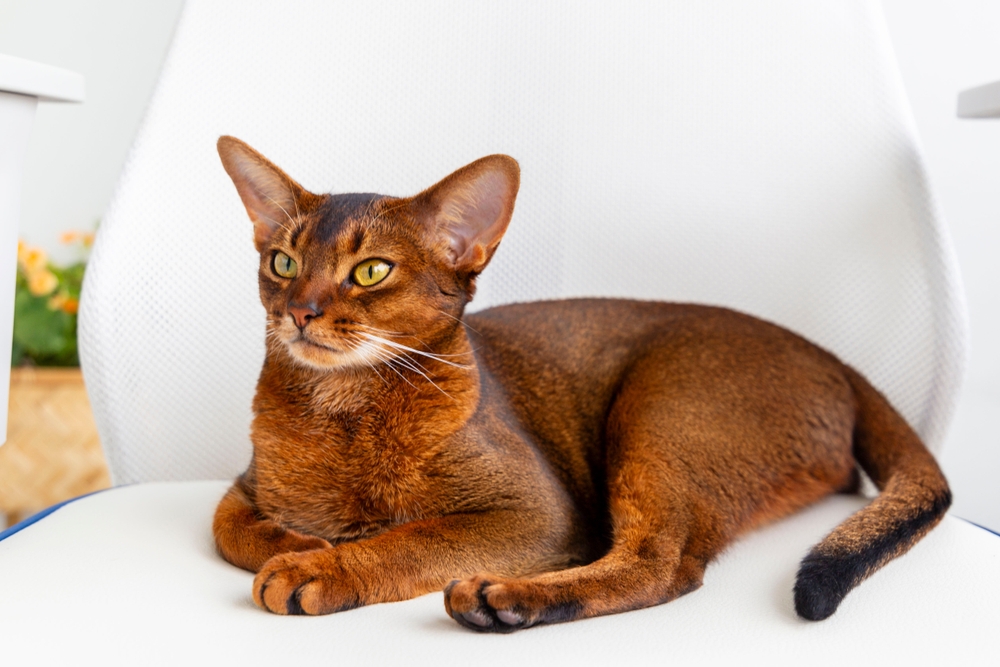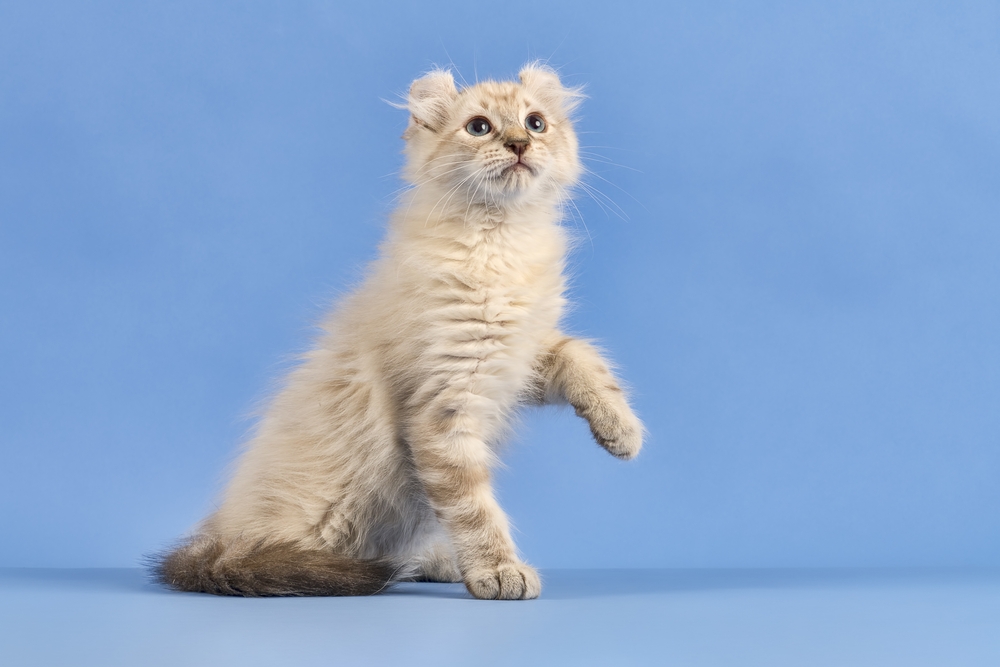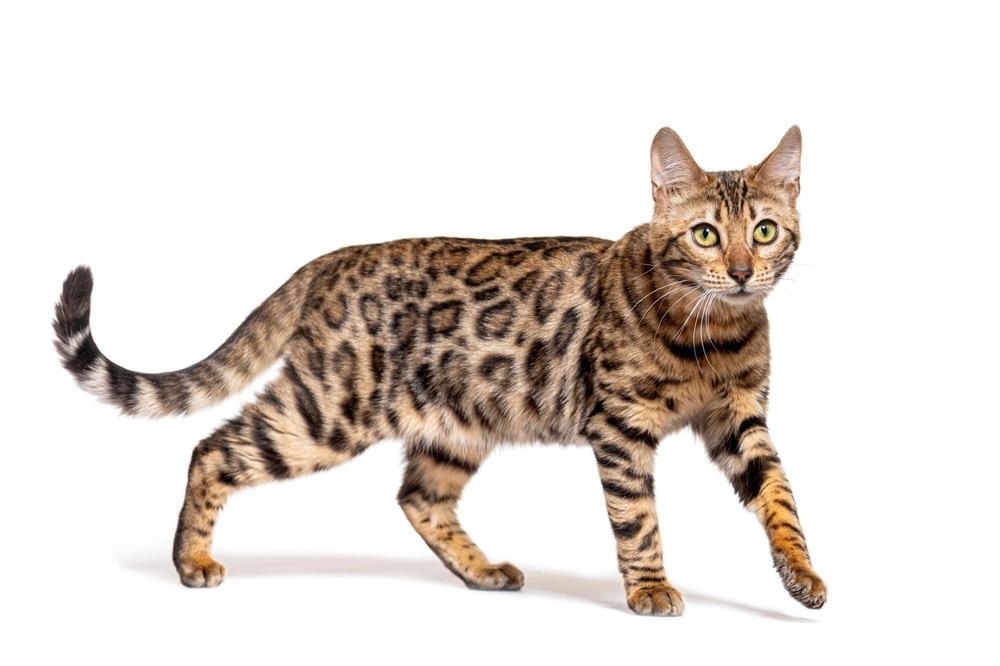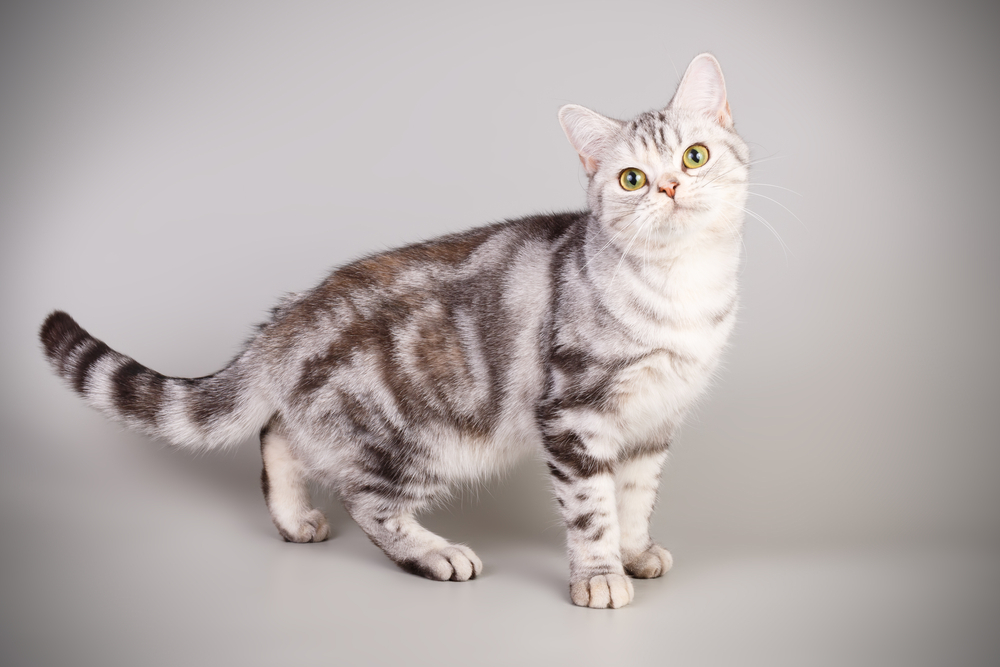The Bombay was developed by crossing the Burmese with the black American Shorthair. Of all breeds, it is closest to the Burmese in temperament and appearance, but with a sleek black coat and copper-gold eyes.
About
The Bombay cat, often called the “parlor panther,” is a sleek and elegant breed celebrated for its jet-black coat and striking copper or gold eyes. Medium in size with a muscular yet graceful build, the Bombay carries an air of mystery and refinement. Its coat is short, close-lying, and gleams with a patent-leather sheen, giving it the appearance of a miniature panther. Rounded features define the breed: a round head, round eyes, and rounded ears that enhance its expressive, captivating look.
The Bombay (Felis catus), belonging to the family Felidae, was developed in the United States during the 1950s by breeder Nikki Horner of Louisville, Kentucky. She crossed sable Burmese cats with black American Shorthairs to create a domestic cat with the appearance of a small black panther but the affectionate, people-oriented temperament of a companion pet. The breed was officially recognized in the 1970s.
Typically weighing 6–11 pounds (2.7–5 kg), the Bombay is moderately sized but solid and muscular. Despite its sleek build, it feels heavier than it looks when picked up. Its coat requires minimal grooming, as the fine hair lies flat and rarely tangles.
Bombays are affectionate, intelligent, and social, often seeking close contact with their families. They tend to follow their humans around the house, curl up in laps, and greet visitors warmly. Playful yet not overly hyperactive, they adapt well to family environments and are known to get along with children and other pets. Their soft, musical voices are used to communicate affection rather than demand attention.
With their shiny black coats, piercing eyes, and endearing personalities, Bombay cats embody the allure of the wild panther while offering the warmth and devotion of a loyal companion.
Physical Characteristics
Coat: The Bombay has a short, sleek, and fine-textured coat that lies close to the body. Its fur is jet-black from root to tip, with a glossy, patent-leather shine that makes the breed especially striking. Unlike some black cats whose coats may show faint shading, the Bombay’s is pure black.
Face: They have a rounded head with a short muzzle and well-developed whisker pads. Their eyes are large, round, and expressive—ranging in color from gold to deep copper, which stand out vividly against the black coat.
Body: The body is medium-sized, muscular, and compact, often described as “panther-like.” Despite their sleek appearance, Bombays are surprisingly solid and heavier than they look.
Ears: Medium in size, slightly rounded at the tips, and set wide apart, complementing the rounded head shape.
Tail: Straight, medium in length, and proportionate to the body, tapering slightly to a rounded tip.
Size:
-
Length: About 13–16 in (33–41 cm) from head to base of tail.
-
Height: Around 9–11 in (23–28 cm) at the shoulder.
Weight:
-
Adult Female: 6–9 lbs (2.7–4.1 kg).
-
Adult Male: 8–12 lbs (3.6–5.4 kg).
The Bombay’s solid black coat, copper-gold eyes, and muscular yet graceful build give it the appearance of a miniature black panther—one of the most distinctive and dramatic looks among domestic cat breeds.
Reproduction
Mating and Courtship:
Bombay cats reach sexual maturity around 6–9 months of age, though responsible breeding usually begins after 12 months. Females in heat display classic signs such as increased vocalization, rubbing, and rolling. Males respond with pursuit and courtship behaviors, often accompanied by loud calling.
Breeding Season:
They can breed year-round, but queens may experience more frequent heat cycles during spring and summer when daylight hours are longer.
Gestation:
The gestation period lasts about 63–65 days (roughly 9 weeks).
Birth of Kittens:
A typical litter size is 3–5 kittens, though litters can range from 1 to 7. Bombay kittens are born with blue eyes and often lighter coats that darken as they mature, turning into the breed’s signature glossy black.
Care and Nurturing:
Kittens are born weighing about 3–4 oz (85–113 g), blind and fully dependent on their mother. Bombay queens are attentive, often protective mothers who provide consistent nursing, grooming, and warmth.
Weaning and Social Development:
-
Eyes open between 7–10 days.
-
Walking begins around 3 weeks.
-
Solid food is introduced by 4–5 weeks, and weaning usually completes by 8–10 weeks.
-
Bombay kittens tend to develop a strong bond with humans early, reflecting the breed’s affectionate temperament.
Independence:
By 12–14 weeks, kittens are ready for adoption, having developed social skills, litter training, and playful behaviors. Reputable breeders often keep kittens until 12 weeks to ensure full development and good adjustment.
The Bombay’s reproductive cycle follows the general pattern of domestic cats, but their signature jet-black coat and copper-gold eyes become more pronounced as the kittens grow, making their development particularly fascinating to watch.
Lifespan
Lifespan in the Home:
Bombay cats generally live 12–16 years, with many reaching 17–20 years when provided with proper veterinary care, nutrition, and a safe indoor lifestyle.
Lifespan in Outdoor or High-Risk Settings:
Outdoor Bombays are more vulnerable to traffic accidents, disease, predators, and theft (because of their rare, panther-like appearance). In such cases, lifespan may be reduced to 6–10 years.
Factors Affecting Longevity:
-
Genetics: Generally healthy, though the breed may be predisposed to hypertrophic cardiomyopathy (HCM), craniofacial defects (from their Burmese ancestry), and potential respiratory issues due to their shorter muzzle.
-
Nutrition & Exercise: A balanced, high-protein diet and weight management are essential, as Bombays can be prone to obesity if overfed.
-
Preventive Care: Regular vet checkups, dental hygiene, and vaccinations extend their lifespan significantly.
-
Environment: Indoor living with safe enrichment (toys, climbing posts, interactive play) reduces risk and supports long-term well-being.
Notable Longevity:
With attentive care, some Bombays have lived 18–20+ years, making them one of the longer-lived pedigreed cat breeds.
The Bombay’s strong health, affectionate temperament, and adaptability mean that with the right care, they can enjoy a long, vibrant life as loyal companions.
Eating Habits
Diet:
Bombays are obligate carnivores and require a diet high in animal-based protein. They thrive on premium commercial cat food—wet, dry, or a combination—that meets AAFCO nutritional standards. Wet food is especially beneficial for hydration and urinary health, while dry kibble can help maintain dental hygiene.
Feeding Frequency:
-
Kittens (up to 6 months): 3–4 small meals per day to support rapid growth.
-
Adults (6 months–10 years): 2 meals daily, with portion control to prevent overeating.
-
Seniors (10+ years): Smaller, more frequent meals, often with specialized senior formulas to support kidney, heart, and joint health.
Special Considerations:
-
Bombays can be prone to obesity if overfed, since they enjoy food and may beg for extra portions. Careful calorie monitoring is important.
-
Their Burmese ancestry gives them a hearty appetite, so balanced meals with lean proteins (chicken, turkey, fish, beef) help maintain muscle without excess weight.
-
Fresh water should always be available, as hydration is vital for kidney and urinary tract health.
Treats:
Occasional treats like freeze-dried meat, cooked chicken, or commercial cat treats are acceptable, but should not exceed 10% of daily caloric intake.
Feeding Enrichment:
Because Bombays are intelligent and playful, puzzle feeders, food-dispensing toys, or rotating meal stations can keep them mentally stimulated and slow down fast eaters.
The Bombay’s eating habits reflect its affectionate yet food-motivated personality—they thrive on high-protein, portion-controlled diets combined with interactive feeding to balance appetite, health, and activity.
Uniqueness
Miniature Panther Appearance:
The Bombay is often called the “parlor panther” because of its sleek, jet-black coat, muscular body, and striking copper-to-gold eyes, making it resemble a small black panther.
Shiny Patent-Leather Coat:
Unlike many black cats whose coats may appear brownish in certain light, the Bombay’s fur is true black from root to tip and has a glossy, almost mirror-like sheen.
Burmese and American Shorthair Heritage:
The breed was created in the 1950s by crossing Burmese cats with black American Shorthairs, producing a unique blend of the Burmese’s affectionate personality and the Shorthair’s sturdiness.
Affectionate and People-Oriented:
Bombays are highly social, often forming strong bonds with their owners. They enjoy following family members around, sitting on laps, and participating in daily activities.
Adaptable and Calm Nature:
While playful and intelligent, Bombays are known for being easygoing and adjusting well to different households, making them excellent family cats.
Expressive Eyes and Voice:
Their large, round eyes are one of the most striking features, glowing against the dark coat. They are also moderately vocal, using soft, distinctive meows and purrs to communicate.
Rare Breed Status:
Despite their beauty and charm, Bombays remain relatively rare compared to other domestic breeds, adding to their mystique and uniqueness.
The Bombay’s combination of exotic looks, affectionate personality, and rare status makes it one of the most distinctive and captivating cat breeds, embodying both elegance and companionship.
Be the First to Share Photos of This Species.
FAQ’s
1. What is the closest species or breed to the Bombay Cat?
2. How does the Bombay Cat compare to other cats?
Compared to most domestic cats, Bombays are more affectionate, people-oriented, and lap-loving. They are calmer than high-energy breeds like the Bengal or Abyssinian but more social and interactive than independent breeds such as the Russian Blue. Their glossy black coat and glowing eyes give them an exotic “mini-panther” appearance unmatched by other cats.
3. What national parks or regions provide the best chance to see a cat resembling the Bombay?
While no wild cat is completely black like the Bombay, their appearance most closely resembles melanistic (black) variants of wild cats found in nature, such as:
-
Kabini and Nagarhole National Parks, India – Known for sightings of melanistic leopards, often called black panthers.
-
Costa Rica’s Corcovado National Park – Occasional sightings of melanistic jaguars.
-
Chitwan National Park, Nepal – Home to leopards, including rare black-coated individuals.
These wild cats mirror the Bombay’s panther-like look, making the breed’s nickname—“the parlor panther”—especially fitting.



































































